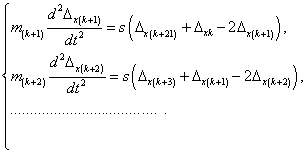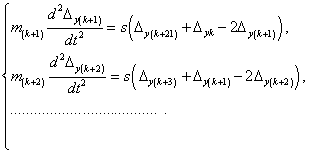| V.2 No 1 | 89 |
| Bend effect on vibration pattern | |
|
|
First of all note that according to the conventional rule of coordinate transformation, we can substitute in (1) and (3) the parameters describing the shift of kth mass located at the bend |
|
|
(5) |
The similar relation will be true
for the rest elements of a line located after the bend. Taking this into account, multiply
(2) into cos |
|
|
(6) |
Multiplying (2) into sin |
|
|
(7) |
Integrating (1), (3), (6) and (7)
and noting (4), we see that the transformed system of differential equations is already
independent of the angle As opposite to this, if the
longitudinal and transverse stiffnesses of an elastic line were different, then in the
initial modelling systems of differential equations we have to introduce the stiffness slt
in (1) and (2), and str, str The proven theorem can be easily
extended to the generalised coordinates of an elastic system. At the same time, the
definition of generalised coordinates per se cannot substitute the essence of the proven
assertion, since, according to the theorem, the modelling system much simplifies with the
equal longitudinal and transverse stiffness, and instead two systems ( In this paper we will determine the solution for some models of elastic lines in the course of whose investigation this theorem is valid and which are widely applicable to the specific problems. |
|


